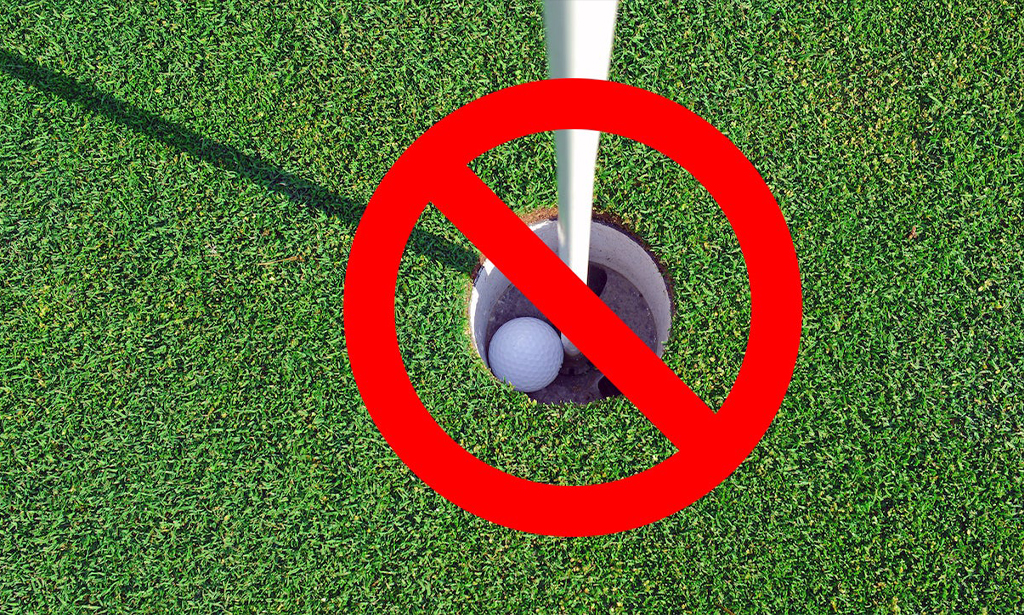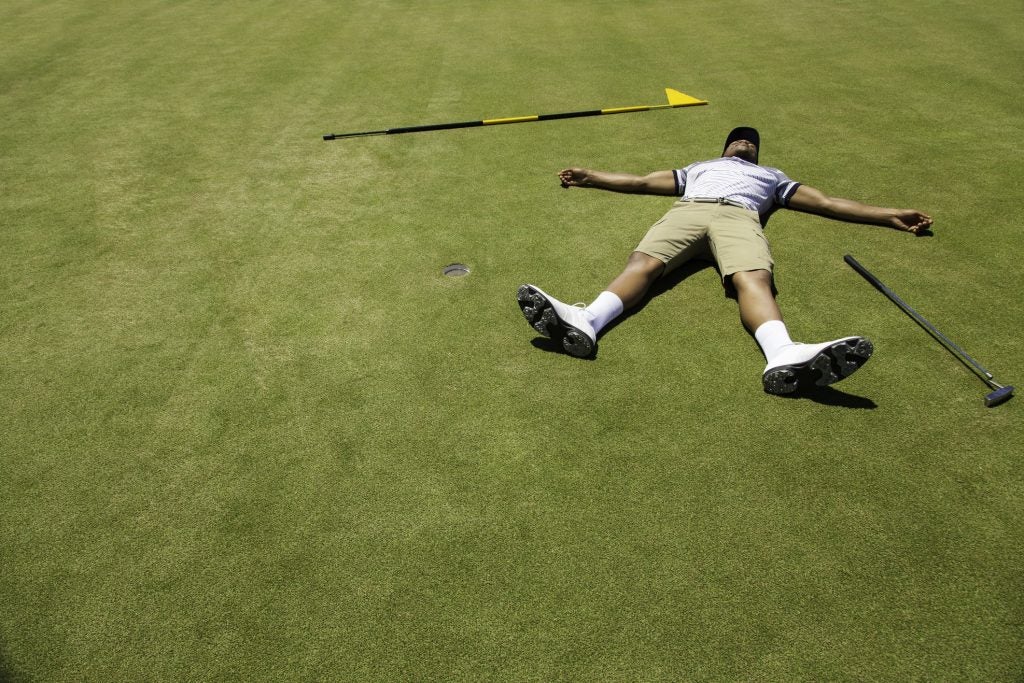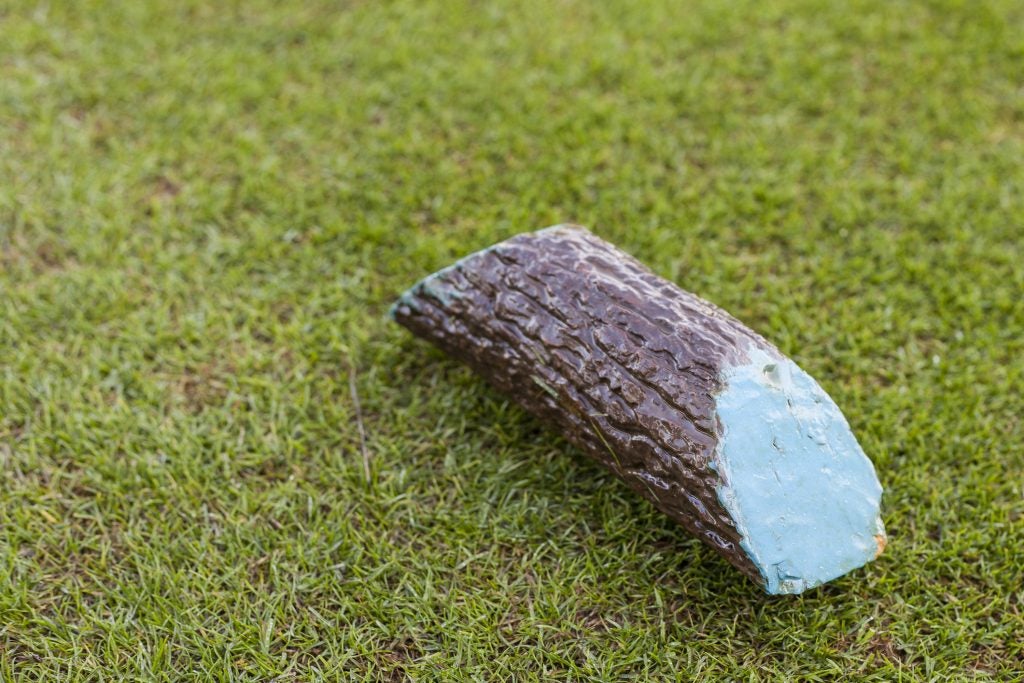Blog
21 Times a Hole-in-One Absolutely Doesn’t Count

Holes-in-one, whether you’ve had a bunch of them or are still chasing that elusive first (like our resident writer Alan Shipnuck) are great fun. It’s part of the fabric of golf; something we all strive for. So much so that we’ll even bend the rules ever-so-slightly in pursuit of one. But I’m sorry, that stuff won’t fly around these parts.
Holes-in-one are special because they’re so rare. There aren’t any shortcuts. It’s why I’ve put together this handy list outlining all the times making a hole-in-one absolutely doesn’t count.
1. After A Mulligan
Sad, but true. Let’s say you’re playing a par 3, shank one into the water, drop a sneaky mulligan down with the consent of your playing partners, and knock it in the hole. A fun story, no doubt, but it doesn’t count as a hole-in-one. Proper holes-in-one need to have a legitimate, USGA-abiding score attached to them.
2. After A Penalty Shot
Similar to the one above, the only difference is that, technically speaking, you do register a score that would hold muster with the USGA. The only problem is that if you knock one in the water, re-tee then knock it into the hole, it can’t be a hole-in-one because it’s literally not a hole-in-one. It’s a hole-in-three. Just another par, in the black and white on the scorecard.
It also violates another rule of mine…
3. Multiple Attempts On The Same Hole
I love the European Tour’s hole-in-one videos. Love them. But when you have that many attempts with no actual score attached to the end of it, and when you’re standing in front of the golf gods at the pearly gates of golf heaven, this won’t go down as an *actual* hole-in-one.
4. On A Par-3 Course
Yes, technically you are playing an actual course and registering a legitimate score, but there’s something about it that doesn’t feel right. True holes-in-one are registered on golf courses where par 3s are few-and-far between.
5. Temporary Green
This is a little harsh because there’s not really much the player themselves can do about it, but temporary greens present all kinds of problems. The grass almost never actually resembles that of an actual green, and the holes can often be cut incorrectly. The yardage gets thrown off along the way; not exactly the fairest platform for claiming a hole-in-one.
6. In a Golf Simulator
I love golf simulators, and living in New York City, use them all the time to get my golf fix in. I’ve actually made a hole-in-one on a simulator once. Do I go around claiming it as an actual hole-in-one? No, I don’t, because it’s not an actual hole-in-one.
7. Scramble
If there’s a common theme among all these things, it’s that holes in one need to be registered in legitimate, law-abiding rounds that the USGA would approve of counting toward your handicap. A scramble, fun as they are, doesn’t fit that criteria.
8. When You Play An Odd Number Of Holes
Play three holes and make a hole in one on one of them? Then play the final six holes to get your nine-hole score. I’m not sure holes-in-one can exist in isolation; they need to be part of a larger round, either 9 or 18.

9. When Somebody Else Knocks In Your Ball For You
This one should be obvious. You hit your ball on the green, perhaps close to the hole, then your buddy in the group ahead putts your ball into the hole for you. Hilarious! But not an actual hole in one.
10. Signing An Incorrect Card
This one is savage, but if you’re playing in a tournament and make a hole-in-one, only for your playing partner to mark it incorrectly on a scorecard you end up signing. Technically speaking — and heartbreakingly so — that’s no longer an official hole-in-one.
11. When You’re Not Keeping Score
You’re out there, having fun, playing a casual round and taking a few mulligans along the way. Then, you waltz up to a par 3 and knock it in the hole. It violates my rule of a hole-in-one needing to be a part of a legitimate round.
You could go back and count up your score, of course, but that presents a different problem.
12. After a Breakfast Ball
Alright, so you’re on the first tee, blow one out of bounds, take a customary breakfast ball and pipe it down the middle. Let’s say that’s your only mulligan of the day. Fast forward a few holes and you make a hole-in-one. This round wouldn’t hold up in a tournament, so does this hole-in-one count? No comment.
13. Double Green, Wrong Pin
Can’t make a hole-in-one on a hole that isn’t the one you’re playing. Simple.
14. In Front Of Tee Markers
It’s the Rules of Golf. If you tee off from in front of the tee markers, it’s not a legitimate shot. Would take a bold playing partner to call that on you, though.
15. Wrong Tee Markers
See above.

16. Borrowed Club
You grab your buddy’s club and knock it in the hole. Alas, that violates the Rules of Golf. So nice shot! But not a hole in one.
17. Bonus Holes
A fair amount of golf courses have bonus holes to help players settle bets, and they’re usually par 3s. Let’s say you’re all-square in a match after 18, so you play a bonus hole and make an ace. Great job, and even better story. But is that an official hole-in-one? Eh.
18. Using An Illegal Club
This doesn’t just not count, it’s also cheating. For shame!
19. If It’s Embedded Against The Lip
This one’s already been settled. It’s not a hole-in-one, because it’s embedded against the lip.
20. Miniature Golf or Video Game Golf
This one should be so obvious I’m not even going to bother explaining why.
21. Grounds For Any Other DQ
The common theme here is that true holes-in-one count only during legitimate, complete rounds which could count toward your handicap. We’ve tried outlining some of the most common ones, but wanted to include this catch-all for any others we have have missed.
By Luke Kerr-Dineen on Golf.com
Blog
When Golf Gadgets Fail: Navigating Common Tech Mishaps on the Golf Course
A Look at What Happens When Modern Golf Gadgets Go Wrong

Imagine this: you’re on the golf course, teeing off on a beautiful, sunny day. With the help of your trusty golf gadget, you’re confident you’ll hit a birdie or even an eagle. But just when you’re about to swing, your gadget malfunctions. Suddenly, your perfect game is thrown into chaos. Welcome to the world of technology fails, where even the most advanced golf devices can sometimes let you down. In this article, we’ll explore some common tech fails and provide some tips on how to handle them.
When Golf Gadgets Let You Down
Modern golf devices, from smart clubs to digital scorecards to GPS-enabled watches, have revolutionized the game. They provide golfers with real-time data, helping them refine their swing, choose the right club, and navigate the course. But what happens when these devices fail?
Unreliable Data
One of the most common golf gadget fails is inaccurate or unreliable data. GPS devices might show the wrong distance to the pin, swing analyzers might give incorrect feedback, and digital scorecards might miscalculate your score. This can be frustrating, especially when you’re relying on these devices to improve your game.
Battery Drain
Another common issue is battery drain. Many golf gadgets require a significant amount of power, and if they’re not properly charged, they can die in the middle of a game. This leaves you without the data you need to make informed decisions on the course.
Technical Glitches and Malfunctions
Sometimes, golf devices just stop working. They might freeze, crash, or refuse to turn on. These technical glitches can be caused by software bugs, hardware issues, or even user error.
Preventing Golf Gadget Fails
While it’s impossible to prevent all golf gadget fails, there are steps you can take to minimize the risk.
Regular Updates
Keeping your devices updated can help prevent software-related issues. Regular updates often include bug fixes and improvements that can enhance the performance of your device.
Proper Charging
To avoid battery-related problems, make sure to fully charge your devices before hitting the course. Some devices also have power-saving modes that can help extend battery life.
Backup Plan
It’s always a good idea to have a backup plan in case your devices fail. This might mean carrying a traditional scorecard or having a basic understanding of how to calculate distances without a GPS.
When Gadgets Go Wrong: The Bottom Line
Golf gadgets are a fantastic tool for any golfer looking to improve their game. However, like all technology, they can sometimes fail. By understanding the common issues and how to prevent them, you can ensure you’re prepared for any tech-related hiccups on the course. After all, golf is about more than just the gadgets—it’s about the experience, the skill, and the love of the game.
Blog
Mastering the Art of Overcoming Choking under Pressure: Strategies for Peak Performance
Learn the skills needed to stay calm under pressure.

Imagine this: you’ve spent countless hours honing your skills, preparing for that big presentation, important meeting, or decisive sports match. But, when the big moment arrives, instead of performing at your best, your mind goes blank, your hands shake, and you flub it. The dreaded phenomenon of ‘choking under pressure’ can strike anyone, from the seasoned professional to the eager amateur. So, how do you overcome this common mental roadblock? In this article, we’ll explore effective strategies to help you conquer the fear of choking and elevate your performance under pressure.
Understanding Choking under Pressure
Before you can overcome choking, it’s crucial to understand what it is. Psychologists define choking as performing below your ability under pressure. This can be due to heightened anxiety, overthinking, or fear of failure. The irony is, the more you care about performing well, the more likely you are to choke.
Why Do We Choke?
Several factors contribute to choking under pressure. Here are a few:
-
- Fear of Negative Evaluation: The fear of being judged negatively by others can cause significant anxiety, leading to poor performance.
- High Stakes: When the stakes are high, and the outcome is important, the pressure can cause you to underperform.
- Overthinking: The tendency to scrutinize every detail in high-pressure situations can divert your focus from the task at hand.
Strategies to Overcome Choking
Now that we understand why we choke, let’s delve into strategies to prevent it:
- Practice Under Pressure: Simulate high-pressure situations during practice to acclimate yourself to the stress.
- Focus on the Process, Not the Outcome: Concentrating on the process helps keep your mind focused and prevents overthinking.
- Use Positive Affirmations: Positive self-talk can boost your confidence and reduce anxiety.
Case Studies: Athletes Overcoming Choking
Many successful athletes have overcome choking to deliver exceptional performances. Take Michael Jordan, for example. He often missed crucial shots early in his career but used these failures to fuel his determination and eventually became renowned for his clutch performances. Similarly, Serena Williams has bounced back from choking in several matches to claim victory, demonstrating her mental toughness.
Choking under pressure is a common phenomenon, but with the right strategies, it can be overcome. By understanding the causes of choking and implementing techniques like practicing under pressure, focusing on the process, and using positive affirmations, you can learn to perform at your best when it counts the most. Remember, it’s not about never feeling pressure; it’s about learning how to thrive within it.
As Michael Jordan said, “I’ve missed more than 9,000 shots in my career. I’ve lost almost 300 games. 26 times, I’ve been trusted to take the game-winning shot and missed. I’ve failed over and over and over again in my life. And that is why I succeed.” So, next time you face a high-pressure situation, think of it as an opportunity to grow, not a threat to be feared.
If you’ve enjoyed this article and want to learn more about mastering your mental game, subscribe to our newsletter for more tips and strategies. Or, if you’re ready to take your mental toughness to the next level, check out our other articles designed to help you conquer pressure and perform at your peak.
Blog
Golf Course Aesthetics: Exploring the Artistry of Manicured Landscapes
Imagine standing at the tee of a beautifully manicured golf course, gazing out across a landscape of rolling greens, sculpted bunkers, and artfully placed bodies of water.

The Intersection of Golf and Art: Viewing Golf Courses as Living Masterpieces
Imagine standing at the tee of a beautifully manicured golf course, gazing out across a landscape of rolling greens, sculpted bunkers, and artfully placed bodies of water. The course stretches out before you like a canvas, a living masterpiece of design and nature. This is where golf and art intersect, where the game becomes more than just a sport and the course becomes more than just a playing field. It is a crossroads where the beauty of nature and the aesthetics of design come together to create a truly unique experience.
Understanding Golf Courses as Works of Art
Golf courses are meticulously designed and maintained, with every element placed with purpose and intention. They are the result of careful planning, creative vision, and a deep understanding of both the game of golf and the principles of landscape design. In this way, they can be viewed as works of art, with the designer acting as the artist and the landscape serving as the canvas.
The Aesthetics of Golf Course Design
Golf course design is a subtle blend of art and science. Designers must consider a range of factors, including the natural features of the landscape, the skills and abilities of the players, and the overall aesthetic of the course.
Key elements of golf course design include:
- Landscape: The natural features of the landscape, including trees, water bodies, and elevation changes, are integral to the design of a golf course.
- Layout: The layout of a golf course is carefully planned to provide a balance of challenge and enjoyment for players.
- Hazards: Hazards, such as bunkers and water bodies, are strategically placed to add challenge and visual interest to the course.
- Green Complexes: These are the areas surrounding the putting surfaces. They include elements such as bunkers, mounds, and grassy hollows, all of which contribute to the aesthetic appeal and challenge of the course.
The Artistic Influence on Golf Courses
Many renowned golf course designers approach their work with an artist’s eye. They view the landscape as a blank canvas, using the natural features of the land and the principles of design to create an aesthetically pleasing and challenging course.
One of the most influential golf course designers, Alister MacKenzie, was actually a trained surgeon before he turned his hand to course design. His medical background gave him a unique perspective on the relationship between the human body and the landscape, and he used this knowledge to create courses that were both beautiful and challenging to play.
In his book, “The Spirit of St. Andrews,” MacKenzie wrote, “A golf course should be a beautiful place, so arranged that it pleases the eye and stimulates the mind, while the game itself brings the muscles into play.” This philosophy is evident in his designs, which are renowned for their natural beauty and strategic complexity.
Golf Course Design and Environmental Art
In recent years, there has been a growing recognition of golf course design as a form of environmental art. This is due to the increasing focus on sustainability and environmental conservation in the design and maintenance of golf courses.
An excellent example of this is the work of Bill Coore and Ben Crenshaw, who are known for their minimalist approach to course design. Their courses are designed to fit seamlessly into the natural landscape, with minimal alteration of the land. They use the existing topography and vegetation to create a course that is both challenging and visually stunning.
The Future of Golf Course Design
As we look to the future, the intersection of golf and art is set to become even more pronounced. With advances in technology, designers have increasingly sophisticated tools at their disposal, allowing for even greater creativity and innovation in course design.
At the same time, there is a growing emphasis on sustainability and environmental stewardship, with designers striving to create courses that are not only beautiful and challenging to play, but also in harmony with the natural environment.
In conclusion, golf courses are far more than just playing fields for a game. They are living canvases, where the artistry of design meets the beauty of nature. Whether you’re a golfer or not, the next time you step foot on a golf course, take a moment to appreciate the artistry and design that has gone into creating that space. It’s a testament to the incredible intersection of golf and art, and a reminder that sometimes, the crossroads of different worlds can create something truly beautiful.
-

 Product Review6 years ago
Product Review6 years agoThe Perfect Practice Putting Mat Review by Jason Tenzer
-

 Blog4 years ago
Blog4 years agoLoophole Rule Offers PGA Tour Pros a Mulligan
-

 Blog4 years ago
Blog4 years ago2021 Buyer’s Guide: The Top 10 Value Golf Balls For Distance & Feel
-

 Blog4 years ago
Blog4 years agoGolf Marriage Counselor
-

 Product Review6 years ago
Product Review6 years agoTHE ADJUSTABLE IRONS: WALKING STICKS GOLF CLUBS
-

 Blog6 years ago
Blog6 years ago9 Biggest Chokes Of The Past Decade
-

 Blog4 years ago
Blog4 years agoWhat Your Golf Clubs Say About You
-

 Equipment6 years ago
Equipment6 years agoOHK Sports Interview by Jason Tenzer


















